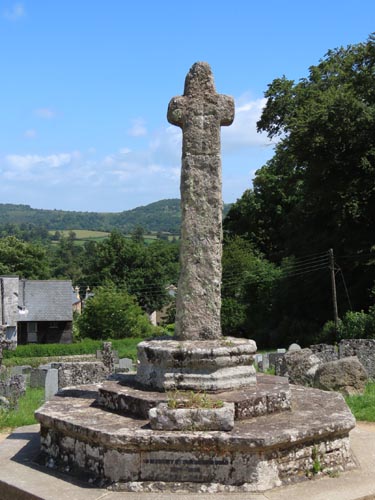 Location:
Beside the path that runs through the churchyard, to the north of the
Church.
Location:
Beside the path that runs through the churchyard, to the north of the
Church.
O/S Grid Ref: SX/70203/87550 Longitude/Latitude (Degrees+/-): -3.83825/50.67309 Map location: Click here to view map. Purpose: War Memorial. Size: 9 feet (2.74 metres) high. 2 feet 2 inches (0.66 metres) across the arms. The incised cross measures 11 inches (0.28 metres) high and 8 inches (0.20 metres) across the arms. Information: During the first half of the 20th Century, the north end of the churchyard was extended to its current size. The cross, which now serves as the town’s war memorial, was assembled from the parts of two separate crosses and erected in this extension during 1928.
The large and ornate socket stone is thought to have originally belonged to the other ancient cross from the town. This, second, cross was reported as being a very large and impressive waymarker. The last reported sighting of it was towards the end of the 19th century, by both William Crossing and G.W. Ormerod, who described it as having been discarded behind the farm buildings at Waye Barton, about ¾ mile to the south west of the town. By this time the head had been removed and both arms had been considerably shortened. It had obviously done service as a gatepost, upside down with its head in the ground, as shown by the gate hangers that were fixed into the shaft. Unfortunately, there are no recent reports of this cross being seen and it is feared that it has been lost forever. The socket stone was discovered at Southmead House, where it was found to have been hollowed out and was in use as a granite trough. This stone is octagonal in shape and its face is slightly concave, with horizontal mouldings running around its circumference. The shaft has been placed in the centre of the socket and is held in position by a number of shaped granite blocks cemented around it. This stone measures 17 inches (0.43 metres) in height. Below the socket stone is an octagonal plinth of two steps, on a raised and narrow octagonal area of grass. The lower step is made up of rectangular granite blocks, cemented together and topped off with granite slabs, whose rounded edges overlap the plinth. This step is 18 inches (0.46 metres) high and a plaque in the side facing the church reads as follows: In Memory of our Heroic
Dead - - - - - - - - - - - - - - - - - Remembering also those from Chagford Who served and returned home - - - - - - - - - - - - - - - - - M M X V
The total height of
the cross extends to a full 12 feet 6½ inches (3.82 metres) above the
surrounding ground. The section of the original cross is 3 feet (0.91
metres) high and its joint with the replacement shaft can easily be seen.
The incised cross is in the centre of the face on the church side of the
cross. Visible signs of weathering over the years can be noticed by the
head,
We would like to thank Bob Noakes for letting us use his photo of the head when it was built into the roadside wall at Holystreet. |